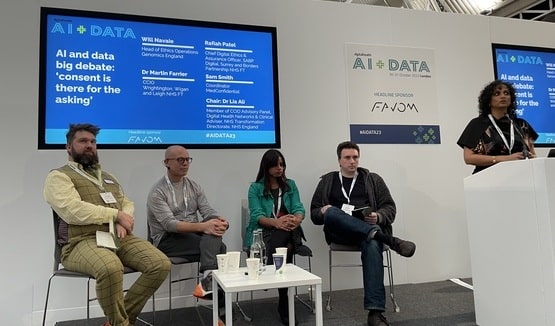Intelligence design
- 17 March 2015

A few short years ago, in the surgical division of Wrightington, Wigan and Leigh NHS Foundation Trust, the quality account was pulled together from information collected and inputted manually by an agency worker.
The system, says deputy director of operations and performance Mary Fleming, was “onerous, and not very robust.”
“Information was being collected from lots of different areas – there was no one version of the truth,” she says. “The agency girl left and we decided to stop it. We wanted to move to an electronic system that would help us really understand what was happening.”
Some three years later, and that’s exactly what they’ve got. The trust has revolutionised its intelligence gathering and reporting, centralising and streamlining it across the board, not just in the surgical division.
Finding a single version of the truth
According to Mark Singleton, head of business intelligence, the idea of finding ‘one version of the truth’ sounds simple, but rolling it out across the trust was quite an achievement.
“It was important to involve key stakeholders from the beginning,” he says. “We brought together a mix of clinicians, operational staff, IT – everyone from executives to the ward clerks.
“We were looking at what the trust measured and monitored and asking ‘does this add value; does it really matter?’ Of course, different divisions were collating different things, and this was the first time that a lot of these things – that had built up over years or even centuries – were being questioned.
“It sounds easy enough but people had beliefs in certain criteria, so we did things like look at national guidance, and at what other trusts were doing, to help us get it right.”
This process led to a list of around 700 metrics to monitor performance, quality, success and care, presented on specially designed dashboards.
Importantly, because everyone is now using the same metrics, it’s possible to analyse and compare what’s actually going on, whether it’s within a specialty, department or unit, at consultant level, or trust-wide.
The design process itself was useful both in creating the culture and environment for the new system to flourish, as well as getting the information right.
“We found it was one of the first times that people from, say, clinical governance and finance, were talking about information, and working with us to bring all the information into one place.
“What’s really great is that managers now don’t have to go through ten different reports to see the impact of something – they can go to just one place.”
Singleton gives the example of an initiative of going into the community to talk to GPs about referral rates. “You can look at the impact on theatre utilisation, waiting times, staffing levels – you’re really seeing the bigger picture,” he says.
Agile thinking
The project was developed using a ‘scrum’ or ‘agile’ technique that involved breaking up the solution into small pieces which would then be released to the clinical or operational staff who would be using them.
“It meant we could see what was working and refine it on a frequent basis,” says Singleton. “Rather than waiting months and ending up with a polished diamond, we gave them versions to play with so that we could make changes as we were going along.”
So how long did it take to get that finished, polished system? “I don’t think it will ever be finished,” he laughs. “It’s always going to be an iterative process.
“For example, at the moment we’re looking at alerts, so that there’s a notification if, say, a patient is nearing the 18-week treatment target. We want to prevent things happening where we can.”
They would also like to whittle down the original 700 metrics, says Fleming. “We have to take a pragmatic view,” she says. “Each division had a wish list, so we brought them together to agree synergies and key performance indicators.”
One of the main benefits of the system is improving awareness and transparency of what’s going on. “It means we can look at the data behind, say, mortality rates,” she says.
“It indicates areas that we need to look at – but it also means we can see where things are going well, and enables us to share best practice.”
Since the tool was introduced, the trust has seen improvements in performance, including a drop in the number of Serious Harms from 128 to 97, and a reduction in the standardised hospital mortality ratio from more than 100 to 70.5.
As intelligence is pulled into the one solution, staff can see more of a ‘story’ than they would have gained from disparate sources. “It’s also about accountability,” says Singleton. “Where there are problems we can see where the accountability lies.”
Going public
The data is also available to the public, adds Fleming, joking: “We’re not afraid!” In fact, she adds, clinicians positively welcome this move
“You’d be amazed at how much information clinicians want. They are very data driven and it helps them to understand what’s going on.
“They don’t feel threatened; they’re not frightened of flags. If we’re doing something wrong we want to know about it. We’re not arguing with the data.”
People trust the data in the trust, adds Singleton. “I’ve worked in organisations were there was so much questioning of the data, but that’s not the case here.”
Users can see how their performance compares with their peers, whether on a ward, specialty or consultant basis, or even with other trusts.
That’s not to say it’s been easy to get here. “It sounds like a simple concept but it’s actually quite complicated,” says Singleton.
“Across the NHS, there are still trusts where people are working in their own silos and reporting in their own silos. But I do think that other organisations are recognising the value of information.
“What we’ve done technically is good – the tools we have are very good – but the success has been down to the level of engagement and culture change in the trust. That’s what’s made the real difference.”
The EHI Awards 2015 are now open for entries. Full details on the awards website.




